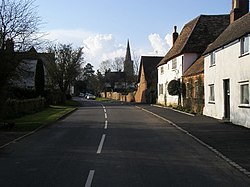Swineshead, Huntingdonshire
| Swineshead | |
| Huntingdonshire | |
|---|---|
 Swineshead | |
| Location | |
| Grid reference: | TL057658 |
| Location: | 52°16’50"N, 0°27’5"W |
| Data | |
| Post town: | Bedford |
| Postcode: | MK44 |
| Dialling code: | 01234 |
| Local Government | |
| Council: | Bedford |
| Parliamentary constituency: |
North East Bedfordshire |
Swineshead is a small and delightful village of Huntingdonshire, in a teardrop-shaped detached part, separated from the body of the shire by no more than a few yards and entirely surrounded by Bedfordshire. The entire village is a conservation area and a great many of its 200 houses are listed buildings.
Land and landscape
The soil in the parish is loam and gravelly and the sub-soil mainly blue galt. The chief crops are wheat, barley beans, and peas. The surface is undulating and is between 139 and 236 feet above sea-level. The village itself stands at about 155 feet. The parish was once well wooded, Swineshead and Spanoak Woods in the north of the parish still remain but now are not as large as they once were.
Parish Church
The Church of St Nicholas consists of a chancel, nave, north aisle with vestry, south aisle, west tower and south porch. The walls are coursed rubble with some pebble rubble, and with stone dressings. The roofs are covered with stone slates, tiles and lead.
The church is not mentioned in the Domesday Book, but there was a rector here before 1271. The whole church seems to have been rebuilt during the 14th century, beginning with the chancel about 1330; about the same time, the south aisle and porch were built. The north aisle with the base of a tower at its west end followed about 10 years later, but the proposed tower was almost immediately abandoned in favour of one at the west end of the nave.
Towards the end of the 15th century, a clerestory was added to the nave, a vestry was added at the east end of the north aisle, with a chamber above it, and a narrow slipway communicating with the chancel. At the same time the chancel arch was widened, rood-stairs built on the south side, and a rood-screen and loft erected.
The nave roof was repaired in 1706 and in 1841. A general restoration seems to have occurred from 1847 to 1853. The tower and spire were again repaired in 1907.
The south aisle of the church contains the mechanism of a 17th-century clock.
History
The parish of Swineshead is recorded as Suineshefet in the Domesday Book of 1086, Swynesheved (13th century) and Swineshead by the 16th century.
The parish has long been connected to Kimbolton in Huntingdonshire, which lies just a few miles off. There is no road between the two villages but the ancient track through the Honeyhill Woods leads between the two. The great manor of Kimbolton owned both villages, and this manor was once the property of Harold Godwinesson, who became King Harold II; the last Anglo-Saxon King of the English. Although King Harold's lands were granted to different persons by William the Conqueror, Swineshead and Stonely both passed to Fitz-Piers and remained united.
Swineshead is listed in the Huntingdonshire entries in the Domesday Book, which records too that land in Kimbolton and in Swineshead was held by William de Warenne.
Swineshead's common fields were inclosed by Act of Parliament in 1803.
|
|
Sights of the village
The village is in the middle of the parish, and includes many old houses, many of which are listed buildings.
The "Three Horseshoes" Inn dates from the early 17th century. The cottages are of brick and timber with tiled and thatched roofs.
The former rectory, now used as a farmhouse, is an ancient plastered building of brick and timber opposite the church. When it was undergoing restoration in 1846, a copy of the seventeenth century "Solemn League and Covenant" (signed by the then Rector of Swineshead) was discovered in the roof where it was perhaps hidden by the cautious rector of the time.
There are the traces of two moats in the village.
Outside links
- The Swineshead 10 – local annual run
- Swineshead Revisited from the Huntingdonshire Society
- Pertenhall and Swineshead Parish Council